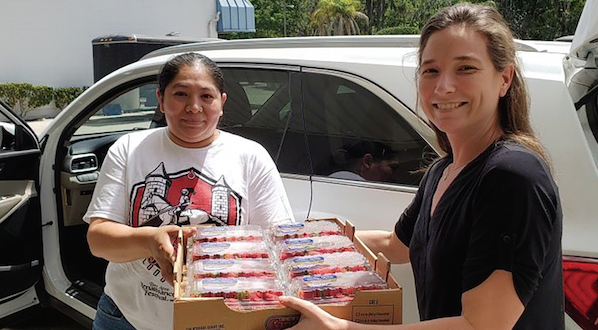

May 1, 2020Virus spread complicates produce growing, markets
Editor’s note: This story was written in early April, as the industry and officials were still adjusting their approach to a global pandemic.
The new coronavirus in March shut down or slowed most U.S. businesses, while specialty crop growers remained a bright spot of industry.
State and federal authorities rightly designated agriculture as a vital enterprise and exempted growers, their employees and other food-related business from shelter-in-place orders and other restrictions.
And so, growers and the greater industry found themselves gearing up for work, while neighbors were slowing down or ceasing.
In March and early April, growers and industry leaders began to navigate rapidly-changing conditions for produce, be it fresh, frozen or processed. Work to meet wild consumer trends, discussion of food safety practices and bravely continuing farm operations were among the rapids they navigated.
Work goes on
Nick Wishnatzki, marketing project manager for Plant City, Florida’s Wish Farms, said April 6 that so far, “there haven’t been any major disruptions to our business per se.”
But he was quick to add that he didn’t want to minimize the challenges Wish Farms had navigated through given the current environment. For instance, the company took the Centers for Disease Control (CDC) guidelines very seriously.
“We are going above and beyond our strict food safety procedures,” he said.
Farm operations continued.
“As far as labor goes, most of our field labor is H-2A,” Wishnatzki said. “While we were concerned initially about delays, we have worked closely with our labor contractors, trade associations and Congressional representatives to streamline the situation. We are hopeful that labor situation has stabilized. That said, our labor contractors are also taking the CDC guidelines very seriously. They are taking a number of precautionary measures to protect the health and safety of workers at the farm.”
Feeling thankful for being able to continue its work, Wish Farms has tried to “pay it forward” by donating 240,000 pounds of fruit, mostly to the charity Feeding Tampa Bay. The United Food Bank of Plant City also received six pallets of strawberries and a donation of $5,000.
“We continue to try and fill needs with a couple of dozen smaller local organizations where we can,” Wishnatzki said. “Starting this week and every following week during this pandemic, we will be dropping off berries to eight local hospitals’ staff as well as fire rescue stations. We are so proud of the people on the front lines and want to show them our deep appreciation for their hard work.”


“Through the efforts of our team at Superfresh Growers, we continue to supply safe, fresh and nutritious Northwest fruit to a world that needs it more than ever,” Director of Marketing Mike Preacher told Fruit Growers News. “The safety of our teams is top priority, of course, so we are adhering to recommendations of federal and local agencies. Despite the challenges, there is an uplifting sense of service across our organization, knowing we are helping communities around the world contend with this crisis.”
It was the same for many other growers of specialty crops.
Optimum Agriculture, a multinational company that manages farmland and agricultural operations in several countries, was concerned about its operations in the Southeast U.S., where it grows watermelons, citrus and a variety of vegetables in Florida and Georgia.
Gaston Marquevich, CEO of Optimum Agriculture, said March 24 it was meeting a variety of challenges. Agricultural labor was a concern. The company had some import activities, and restrictions at the border had been tightened. Even in the office, essential staff’s routines changed drastically.
“We’re following all recommendations in terms of not having any meetings in the office,” he said. “We’re not bringing in any outside people. Of course, it’s not normal.”
Nevertheless, he was determined to continue the production of fruits and vegetables.
“I think the key is, food supply is essential,” he said.
Government recognition
Government officials at the federal, state and local levels agreed, marking agriculture and other food-production activities as exempt from shelter-in-place orders and other restrictions meant to slow the spread of the virus.
At the local level, farms and related food work were exempted from a March 17 shelter-in-place order in Monterey County, California, one of the country’s most prolific specialty crop production areas.
Several state orders, like the March 19 order by Pennsylvania Gov. Tom Wolf, also recognized the importance of food production. In Pennsylvania, fruit and vegetable farming was named in a list of “life-sustaining” jobs that did not have to close their physical locations.
Food and agriculture fall under “critical infrastructure,” as described by the United States Department of Homeland Security, according fact sheet for growers distributed by Purdue University. Farmers and supporting businesses are expected to maintain operations through emergency or disaster.
“While it is unrealistic to expect no impacts from novel coronavirus, people need to eat,” according to Purdue’s guidance. “Food production and distribution should continue.”
Food safety precautions
In late March, the new coronavirus was not widely thought to vector through food, said Erin DiCaprio, a food virologist at University of California-Davis Cooperative Extension.
“There is still no evidence that SARS-CoV-2 is transmitted by food,” she said March 23.
Growers still need to exercise caution, DiCaprio added.
“Food handlers and growers are to follow good manufacturing practices or good handling practices (as they already should be) to minimize contamination of food by ill workers,” she said. “It is critically important that workers showing any symptoms of COVID-19 or who have recent contact with someone that has COVID-19 not work with food.”
DiCaprio said so far there was no evidence a sick-food-worker event had led to any additional coronavirus-related illnesses. But, she added there was the potential.
“The virus can survive on surfaces, so if a sick person were to sneeze or cough on food there is a chance the virus could be present on the food when it reaches the consumer,” she said.
Flexible marketing
Meanwhile in the industry, matching supply with the population’s needs has been a challenge.
“The supply chain is strained to keep up with demand at the retail level,” said Robert L. Guenther, senior vice president of public policy for the United Fresh Produce Association. Strain typically associated with other retail products during a pandemic are also affecting produce sales, he said.
“A lot of it is because the way the supply chain is working now,” he said March 24. “Ready-to-order, lead demand – that kind of system now is being thrown out the window as the retailers are putting more and more requests on their suppliers to get a product to them as quickly as possible. So that’s putting a huge strain on the grower-shippers, the distribution and to the retail channels.”
On the other hand, foodservice and restaurant sales “dried up” almost overnight, Guenther said, due to mandated shutdowns of dine-in restaurants, and closing of schools and other institutions that run foodservice kitchens.
“It gave a shock of seismic proportions,” Guenther said. “Companies who were focused in that part of the industry didn’t have any business. And, in turn, the grower-shippers who supply lost their market, too.”
The trade climate has been disruptive. United Fresh was trying to link up its members who need product to those that have it. Guenther said that buyers seem more interested in “core products” rather than specialty goods – fewer stockkeeping unit numbers, or SKU’s, are listed on orders.
Some companies who have already received product from growers are disrupted enough to have trouble selling it.
“There’s this kind of challenge with cash liquidity – having the cash to keep moving through the system,” he said. United Fresh had asked Congress to establish a $1 billion-$5 billion fund to reimburse grower-shippers directly based on claims made by foodservice distributors.
In the meantime, Guenther said, growers need to keep going to work – even if only to keep the wheels of the industry from getting rusty.
“As someone told me yesterday, ‘Keep the engine oiled,’” Guenther said. “They may not be making money but at least
keep the engine oiled so trucks are moving, and product is moving and suppliers are still doing business.” The industry is talking about creative ways to distribute produce, including through federal nutrition programs or home delivery.
Guenther’s advice to growers was to stay flexible. “You got to look at this on a dayto-day basis, week-to-week basis,” he said. “It’s ever-evolving. We’re facing challenges none of us have ever thought about, and (we) never thought we’d have this kind of environment.”
— Stephen Kloosterman, associate editor














